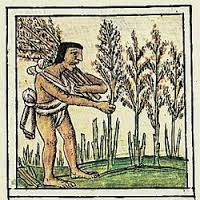THE
HISTORY OF CHOCOLATE
It's
the holiday season and the perfect time to write about one of the most festive
and popular treats in the world, chocolate.
 |
Although chocolate is available almost everywhere today, hand crafted high quality chocolates are a greatly appreciated hostess and holiday gift. |
The story of humans and chocolate began well over two thousand years ago in 'Mesoamerica', the regions now known as Mexico and Central America. It is hard for historians to pin down when chocolate was first introduced, but it is clear that it was cherished from the start. The Latin name for the cacao tree, Theobroma cacao, means "food of the gods." The cacao tree is native to the North American tropics.
Both
the Mayans and Aztecs believed the cacao bean was magical and even held divine
properties, suitable for sacred rituals of birth, marriage and death. Aztec sacrifice victims who were feeling
melancholy were given a gourd of the chocolate cocktail. This was to cheer them
up enough so they could join in the ritual dancing required to make them worthy
to the gods before their death.
The
cacao beans were so important in these great ancient empires that they were
used as currency and could buy food and fowl.
For many centuries chocolate was a bitter drink. The pulp of the cacao fruit which surrounds the beans was fermented into an alcoholic beverage of the time.
 |
The cocoa tree is native to the tropical rain forest of Mexico and Central America. The unripe fruit are brown gourds growing all over the tree. |
For many centuries chocolate was a bitter drink. The pulp of the cacao fruit which surrounds the beans was fermented into an alcoholic beverage of the time.
When
the Spaniards arrived, the famous king of the Aztec's, Montezuma, mistaking the conquistadors on
horses for reincarnated gods of ancient lore, hosted a banquet for the explorer
Hernando Cortes that included the chocolate drink.
 |
Unlike most trees, cocoa sets flowers along its trunk and branches. |
Unsuitable to the European taste they
described it as "a bitter drink for pigs". In spite of this Cortes did bring the
chocolate drink back to Europe where after being mixed with honey or cane
sugar, chocolate quickly became popular throughout Spain.
In
Spain chocolate quickly found disapproval by the Catholic Church. In spite of church preaching chocolate as
the "drink of the devil" it continued to gain popularity in Spain.
By the 17th century chocolate was a fashionable drink throughout Europe believed to have nutritional, medicinal and even aphrodisiac properties. It was rumored to be the favorite drink of Casanova.
 |
When ripe, the football shaped large gourds turn orange and are ready for harvesting. |
By the 17th century chocolate was a fashionable drink throughout Europe believed to have nutritional, medicinal and even aphrodisiac properties. It was rumored to be the favorite drink of Casanova.
In spite of its popularity,
chocolate was too expensive for the masses until the invention of the steam
engine which made mass production possible in the late 1700's. During the Revolutionary War in America,
chocolate was highly valued and it was
included in soldier's rations and used in lieu of payment.
In 1828, a Dutch chemist discovered a way to make powered chocolate by removing half the coco butter from the liquor, pulverizing it and adding alkaline salts to cut the bitter taste. This became known as "Dutch cocoa" and soon after the creation of the first solid chocolate bar.
 |
After the fruit has been cured the beans are ready to be separated from their pulp, dried and roasted. |
In 1828, a Dutch chemist discovered a way to make powered chocolate by removing half the coco butter from the liquor, pulverizing it and adding alkaline salts to cut the bitter taste. This became known as "Dutch cocoa" and soon after the creation of the first solid chocolate bar.
 |
After roasting, the beans are crushed into a powder and are ready for their transformation by chocolate companies and chocolatiers around the world. |
Today
chocolate is a 4-billion-dollar-a year industry in the United States and the
average American eats at least a half pound of chocolate every month.
Although
chocolate should be eaten in moderation, research shows "dark
chocolate" is a rich source of antioxidants
and minerals, and it generally contains less sugar than milk chocolate. Some research suggests that dark chocolate
may help lower the risk of heart disease, reduce inflammation and insulin
resistance, and improve brain function.
People who are interested in adding dark chocolate to their diet should
keep in mind that it is high in fat and calories, so moderation is key. Many
people believe dark chocolate is a mood enhancer and take it to fight the
blues.
Happy Holidays,
James
Thanks to Smithsonian.com (Amanda Fiegl) for the historical information in this
article.




































